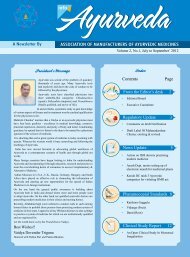Volume 2, No.5, July to September' 2013 - amam-ayurveda.org
Volume 2, No.5, July to September' 2013 - amam-ayurveda.org
Volume 2, No.5, July to September' 2013 - amam-ayurveda.org
You also want an ePaper? Increase the reach of your titles
YUMPU automatically turns print PDFs into web optimized ePapers that Google loves.
BRIEF REVIEW ON ASHWAGANDHA (Withania somnifera L. Dunal)<br />
With special reference <strong>to</strong> its quality, efficacy and safety<br />
Satyajyoti Kanjilal, Arun Gupta, Sanjay Sharma and JLN Sastry<br />
Dabur Research & Development Center,<br />
Sahibabad, Ghaziabad, U.P.<br />
1. INTRODUCTION ON ASHWAGANDHA - PLANT<br />
DESCRIPTION, DISTRIBUTION & CULTIVATION 1<br />
2. QUALITY SPECIFICATIONS OF<br />
ASHWAGANDHA<br />
Withania somnifera commonly known as Ashwagandha, is a dicotyledonous<br />
plant belonging <strong>to</strong> the family Solanaceae. The plant of Ashwagandha<br />
is usually erect, branched, unarmed, shrubby, up<strong>to</strong> 1.25 m in height,<br />
minutely stellate <strong>to</strong>men<strong>to</strong>se especially on the stem, leaf veins and the<br />
calyx. Leaves are simple, petiolate and up<strong>to</strong> 10 cm long. Flowers shortly<br />
pedicullate, 4-6 mm in diameter. Berry globose, enclosed in the green<br />
persistent calyx, 5 mm in diameter, green when unripe, orange-red when<br />
mature, containing numerous small, smooth, discoid seeds. The roots of<br />
the commercial varieties of Ashwagandha cultivated in Madhya Pradesh<br />
are soft textured, tuberous starchy, unbranched or slightly branching in<br />
lower half with slightly fusiform crown, very light, pale brown colour and<br />
smooth thin pale brown Bark. 1<br />
It is a shrubby bush which grows in dry arid soils of subtropical regions.<br />
In India, the plant grows well throughout the drier parts and in the sub<br />
tropical and semi temperate regions, including the states of Maharashtra,<br />
Madhya Pradesh, Gujarat, Rajasthan, Uttar Pradesh, Haryana and Punjab<br />
extending <strong>to</strong> Himachal Pradesh and Jammu and Kashmir from plains <strong>to</strong><br />
the height of 1700 meters. Plant seldom occurs in the north eastern part<br />
covering Orissa, Bengal, Sikkim and Assam. 1<br />
The estimated annual production of Ashwagandha roots in India is<br />
about few thousand <strong>to</strong>nnes. The plant is cultivated mainly in the northwestern<br />
region of Madhya Pradesh and adjoining villages of Kota district<br />
of Rajasthan. Ashwagandha is planted late in the rainy season around<br />
August-September and harvested in the next May. The semi-tropical areas<br />
receiving 500-700 mm rainfall are suitable for cultivation of this rainfed<br />
crop. It requires dry season during its growing period; 1-2 late winter<br />
rains are conducive for the proper development of roots. It grows well<br />
in sandy loam or light red soil, having pH 7.5-8.0, with good drainage.<br />
Seed germination normally takes 6-7 days after sowing. The plant starts<br />
flowering and bearing fruits from February-March onwards. The crop<br />
is ready <strong>to</strong> harvest in April-May i.e. 240-250 days after sowing. The<br />
maturity of crop is judged by drying out of leaves and red berries. The<br />
entire plant is uprooted for roots which are separated from the aerial part<br />
by cutting the stem 1-2 cm above the crown. The roots are then either cut<br />
transversely in<strong>to</strong> small pieces (7-10 cm) or dried as a whole in the sun.<br />
Berries are hand plucked separately, dried, beaten and seeds are taken<br />
out. 1 Ashwagandha has been reported <strong>to</strong> be infected by fungi, viruses,<br />
phy<strong>to</strong>plasmas, nema<strong>to</strong>des and pests. Roots collected in winter, washed<br />
and cut in<strong>to</strong> short pieces. 2<br />
Quality specification of Ashwagandha has been published in various<br />
Pharmacopeias, two of them are referred below -<br />
i. Ayurvedic Pharmacopoeia of India 3<br />
According <strong>to</strong> Ayurvedic Pharmacopoeia of India the following different<br />
parameters are measured for the standardization of Ashwagandha like<br />
Foreign matter (Not more than 2 per cent), Total Ash (Not more than 7 per<br />
cent), Acid-insoluble ash (Not more than 1 per cent), Alcohol (25 per cent)<br />
soluble extractive (Not less than 15 per cent) etc<br />
ii. Indian Pharmacopoeia 4<br />
According <strong>to</strong> the Indian Pharmacopoeia of India 2007, Ashwagandha<br />
contains not less than 0.02 per cent of <strong>to</strong>tal withanolide A and withaferin<br />
A, calculated on the dried basis.<br />
Description: Buff <strong>to</strong> grayish – yellow roots. Taste, slightly mucilaginous,<br />
bitter and acrid.<br />
Identification:<br />
a. Macroscopic – Primary roots are slight, conical or finger like in<br />
shape, variable in thickness with the age. Secondary roots are thin<br />
and fibrous. Surface buff <strong>to</strong> grayish – yellow with longitudinal<br />
wrinkles.<br />
b. Microscopic – Vessels with bordered pits and horizontal perforations.<br />
Fibres aseptate with pointed ends. Wood elements lignified. Starch<br />
grains abundant, simple, mostly spherical, reniform – oval with<br />
central hilum. Microcrystal in parenchyma cells.<br />
c. Thin Layer Chroma<strong>to</strong>graphy –<br />
Mobile phase: A mixture of 9 volumes of chloroform and 1 volume<br />
of methanol.<br />
Test solution: Reflux 3 g of coarsely powdered substance under<br />
examination with 50 ml methanol for 15 minutes, cool and filter.<br />
Reference Solution: Reflux 0.6 g of coarsely powdered ashwagandha RS<br />
with 10 ml methanol for 15 minutes, cool and filter. Apply <strong>to</strong> the plate 10<br />
µl of each solution as bands 10 mm by 2 mm. Allow the mobile phase <strong>to</strong><br />
rise 8 cm above the line of application. Dry the plate in air, spray with<br />
solution of anisaldehyde reagent. Heat at 100 o for 5-10 minutes and<br />
examine the plate in day light. The chroma<strong>to</strong>graphic profile of the test<br />
solution is similar <strong>to</strong> that of the reference solution.<br />
info Ayurveda, <strong>Volume</strong> 2, <strong>No.5</strong>, <strong>July</strong> - Sept’ <strong>2013</strong><br />
9


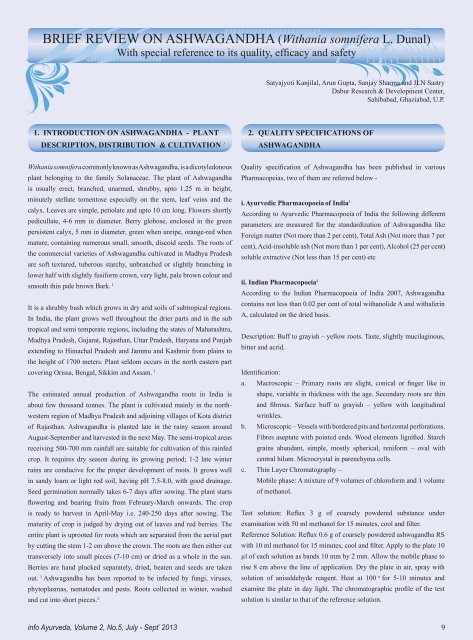

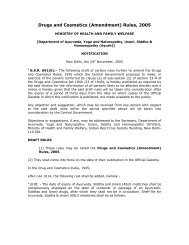
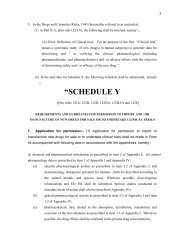
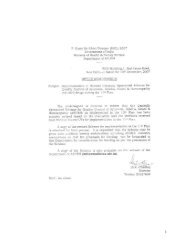

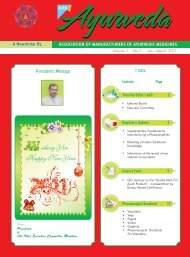

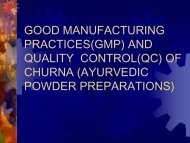
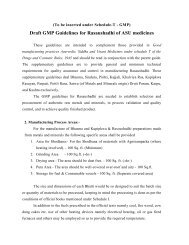
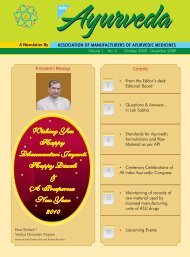
![[To be published in Gazette of India Part II Section 3, sub-section iii]](https://img.yumpu.com/28570283/1/190x245/to-be-published-in-gazette-of-india-part-ii-section-3-sub-section-iii.jpg?quality=85)

